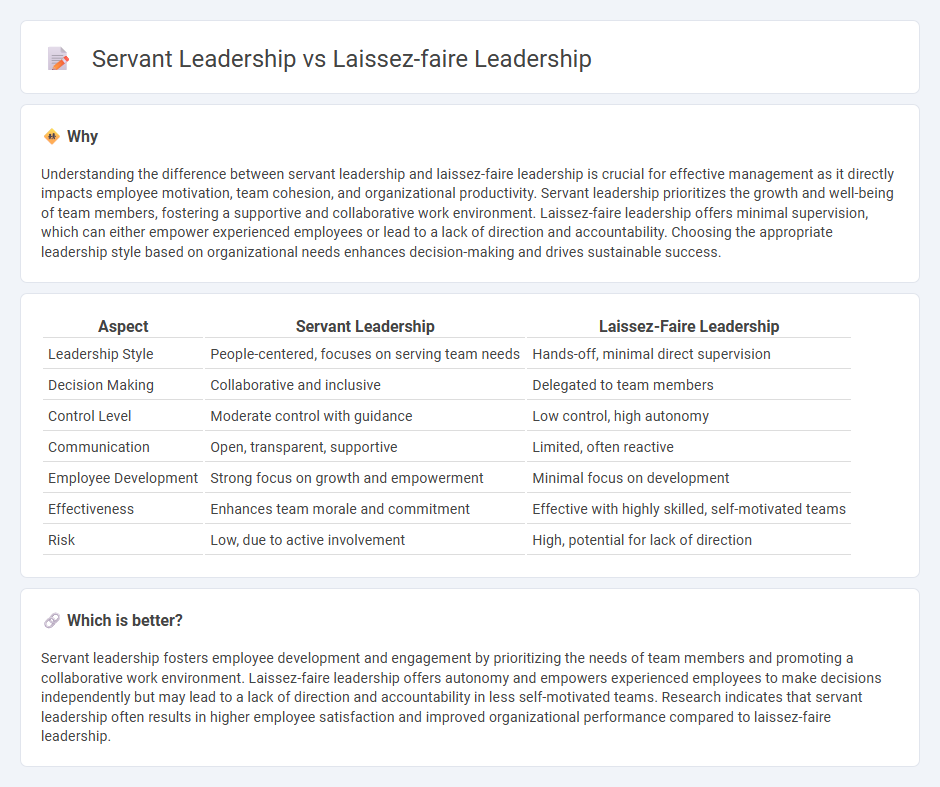
Servant leadership emphasizes prioritizing the needs of team members and fostering their growth, promoting collaboration and ethical decision-making. Laissez-faire leadership provides employees with autonomy and minimal supervision, encouraging self-direction but risking a lack of guidance and accountability. Explore the differences in impact on organizational culture and performance to determine the best fit for your management style.
Why it is important
Understanding the difference between servant leadership and laissez-faire leadership is crucial for effective management as it directly impacts employee motivation, team cohesion, and organizational productivity. Servant leadership prioritizes the growth and well-being of team members, fostering a supportive and collaborative work environment. Laissez-faire leadership offers minimal supervision, which can either empower experienced employees or lead to a lack of direction and accountability. Choosing the appropriate leadership style based on organizational needs enhances decision-making and drives sustainable success.
Comparison Table
| Aspect | Servant Leadership | Laissez-Faire Leadership |
|---|---|---|
| Leadership Style | People-centered, focuses on serving team needs | Hands-off, minimal direct supervision |
| Decision Making | Collaborative and inclusive | Delegated to team members |
| Control Level | Moderate control with guidance | Low control, high autonomy |
| Communication | Open, transparent, supportive | Limited, often reactive |
| Employee Development | Strong focus on growth and empowerment | Minimal focus on development |
| Effectiveness | Enhances team morale and commitment | Effective with highly skilled, self-motivated teams |
| Risk | Low, due to active involvement | High, potential for lack of direction |
Which is better?
Servant leadership fosters employee development and engagement by prioritizing the needs of team members and promoting a collaborative work environment. Laissez-faire leadership offers autonomy and empowers experienced employees to make decisions independently but may lead to a lack of direction and accountability in less self-motivated teams. Research indicates that servant leadership often results in higher employee satisfaction and improved organizational performance compared to laissez-faire leadership.
Connection
Servant leadership and laissez-faire leadership both emphasize empowering team members but differ in approach; servant leadership focuses on serving and developing followers, while laissez-faire leadership provides maximum autonomy with minimal interference. Both styles can enhance employee motivation and innovation by promoting trust and independence. Effective managers integrate elements of servant and laissez-faire leadership to foster a supportive yet self-directed work environment.
Key Terms
Autonomy
Laissez-faire leadership prioritizes high autonomy by allowing team members to make decisions independently with minimal interference, fostering innovation and self-direction. Servant leadership balances autonomy with support, emphasizing leaders' roles in serving and empowering their teams to grow while maintaining accountability. Explore how these leadership styles impact organizational culture and productivity in more depth.
Empowerment
Laissez-faire leadership facilitates empowerment by granting team members autonomy to make decisions and manage their work independently, fostering creativity and personal accountability. Servant leadership empowers through prioritizing the needs and growth of team members, nurturing a supportive environment that encourages collaboration and skill development. Discover more about how these leadership styles uniquely cultivate empowerment in organizations.
Support
Laissez-faire leadership offers minimal direct support, allowing team members autonomy to make decisions and solve problems independently, which can empower experienced employees but may leave others feeling unsupported. Servant leadership prioritizes actively providing support by addressing team needs, fostering growth, and building a collaborative environment that enhances trust and engagement. Explore deeper into how these leadership styles impact team dynamics and performance.
Source and External Links
Understanding Laissez-Faire Leadership - Laissez-faire leadership is a hands-off management style where leaders provide minimal oversight and allow employees autonomy to make decisions, offering guidance and support only as needed, suitable for teams of self-motivated individuals.
Laissez-Faire Leadership Style - This leadership style involves leaders giving minimal guidance, expecting group members to take full responsibility for goal setting, decision making, and problem-solving independently.
Examples of Laissez-Faire Leadership - Laissez-faire leaders hire competent employees they trust to set priorities and accomplish goals while offering support and mentorship without micromanaging, treating mistakes as learning opportunities rather than failures.
 dowidth.com
dowidth.com